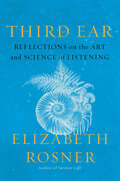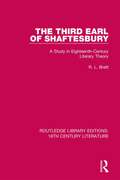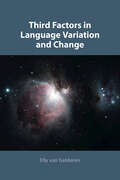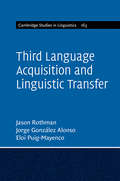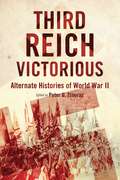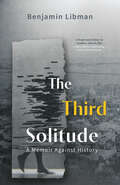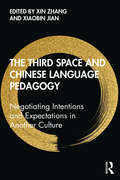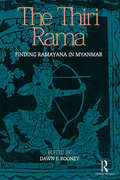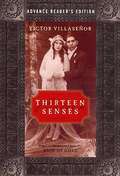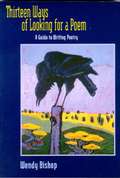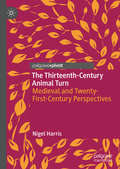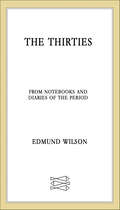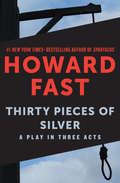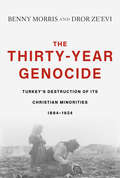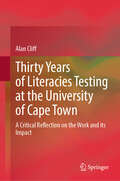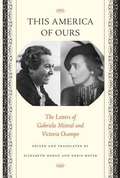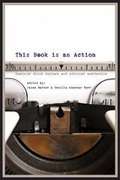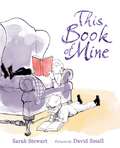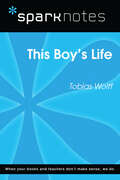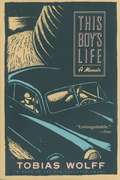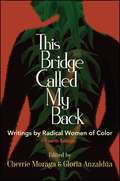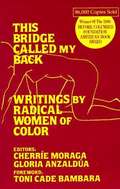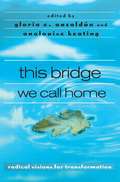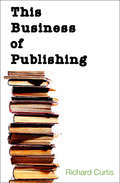- Table View
- List View
Third Ear: Reflections on the Art and Science of Listening
by Elizabeth RosnerThis illuminating book weaves personal stories of a multilingual upbringing with the latest scientific breakthroughs in interspecies communication to show how the skill of deep listening enhances our curiosity and empathy toward the world around usThird Ear braids together personal narrative with scholarly inquiry to examine the power of listening to build interpersonal empathy and social transformation. A daughter of Holocaust survivors, Rosner shares stories from growing up in a home where six languages were spoken to interrogate how psychotherapy, neurolinguistics, and creativity can illuminate the complex ways we are impacted by the sounds and silences of others.Drawing on expertise from journalists, podcasters, performers, translators, acoustic biologists, spiritual leaders, composers, and educators, this hybrid text moves fluidly along a spectrum from molecular to global to reveal how third-ear listening can be a collective means for increased understanding and connection to the natural world.
The Third Earl of Shaftesbury: A Study in Eighteenth-Century Literary Theory (Routledge Library Editions: 18th Century Literature)
by R.L. BrettThe third Earl of Shaftesbury had generally been known as the forerunner of the Moral Sense school of philosophers in the eighteenth century. Surprisingly little attention had been paid to his importance for literature and yet undoubtedly this had been very great. Originally published in 1951, this study gives an account of Shaftesbury’s aesthetic and literary theory; his discussion of the imagination, ridicule, the aesthetic judgment and the sublime; and his anticipation of later writers such as Burke, Coleridge and Kant. It also considers Shaftesbury’s thought as part of the background of ideas in the Augustan period and his influence in such fields as literature, architecture and landscape gardening. In addition, the author assesses in more general terms Shaftesbury’s attempt to maintain a Platonic viewpoint that would be more congenial to poetry than Locke’s "new way of ideas".
Third Factors in Language Variation and Change
by Elly Van GelderenIn this pioneering study, a world-renowned generative syntactician explores the impact of phenomena known as 'third factors' on syntactic change. Generative syntax has in recent times incorporated third factors – factors not specific to the language faculty – into its framework, including minimal search, labelling, determinacy and economy. Van Gelderen's study applies these principles to language change, arguing that change is a cyclical process, and that third factor principles must combine with linguistic information to fully account for the cyclical development of 'optimal' language structures. Third Factor Principles also account for language variation around that-trace phenomena, CP-deletion, and the presence of expletives and Verb-second. By linking insights from recent theoretical advances in generative syntax to phenomena from language variation and change, this book provides a unique perspective, making it essential reading for academic researchers and students in syntactic theory and historical linguistics.
Third Language Acquisition and Linguistic Transfer (Cambridge Studies in Linguistics #163)
by Jason Rothman Jorge González Alonso Eloi Puig-MayencoIs acquiring a third language the same as acquiring a second? Are all instances of non-native language acquisition simply one and the same? In this first book-length study of the topic, the authors systematically walk the reader through the evidence to answer these questions. They suggest that acquiring an additional language in bilinguals (of all types) is unique, and reveals things about the links between language and mind, brain, and cognition, which are otherwise impossible to appreciate. The patterns of linguistic transfer and what motivates it when there are choices (as can only be seen starting in third language acquisition) underscores a key concept in linguistic and psychological sciences: economy. Overviewing the subfields examining multilingual acquisition and processing, this book offers an expanded systematic review of the field of multilingual morphosyntactic transfer, as well as providing recommendations for the future emerging field.
Third Reich Victorious: Alternate Histories of World War II
by Peter G. Tsouras<P> This book is a stimulating and entirely plausible insight into how Hitler and his generals might have defeated the Allies, and a convincing sideways look at the Third Reich's bid at world domination in World War II. <P> What would have happened if, for example, the Germans captured the whole of the BEF at Dunkirk? Or if the RAF had been defeated in the Battle of Britain? What if the U-Boats had strangled Britain with an impregnable blockade, if Rommel had been triumphant in North Africa or the Germans had beaten the Red Army at Kursk? The authors, writing as if these and other world-changing events had really happened, project realistic scenarios based on the true capabilities and circumstances of the opposing forces. Third Reich Victorious is a dynamic and eye-opening alternate history that opens up the dramatic possibilities of World War II.
The Third Solitude: A Memoir Against History
by Benjamin Libman“A frank love letter to modern Jewish life.” — MERVE EMRE, contributing writer, The New YorkerAn intimate memoir in essays seeking familial history and personal memory against the backdrop of the lost world of North American Jewry.What is the past? How can we let it speak on its own terms, without forcing it into the categories of history? In The Third Solitude, Benjamin Libman gathers and weaves the threads of multiple pasts — of his community, of his family, and of himself — in an attempt to escape the inadequate narratives around Zionism that he grew up with, and to create nothing short of a new paradigm. Across a series of interconnected memories, Libman leads us through the many fragments that make a life, unafraid to question deeply cherished beliefs about Jewish identity, and seeks to reconcile his own values with those inculcated in him. Along the way, he casts aside tired tropes and shores together the pieces of a new way of looking toward the future. The Third Solitude is a paean to the art of losing, and to the visions of the past that persist in the present..
The Third Space and Chinese Language Pedagogy: Negotiating Intentions and Expectations in Another Culture
by Xin Zhang; Xiaobin JianThe Third Space and Chinese Language Pedagogy presents the Third Space as a new frame through which foreign language pedagogy is conceptualized as a pedagogy of negotiating intentions and expectations in another culture. The field of Chinese as a foreign language (CFL) in the past decades has been expanding rapidly at the beginning and intermediate levels, yet it is lacking in scholarship on the true advanced level both in theory building and research-supported curriculum and material development. This book argues that it is time for CFL to go beyond merely satisfying the desire of gazing at the other, whether it is curiosity about the other or superiority over the other, to focusing on learning to work with the other. It reimagines the field as co-constructing a transcultural Third Space where learners are becoming experts in negotiating intentions and expectations in another culture. It presents a range of research-based CFL pedagogical scholarship and practices especially relevant to the advanced level and to the goal of enabling learners to go past fans or critics to become actors/players in the game of cross-lingual and intercultural cooperation.
The Thiri Rama: Finding Ramayana in Myanmar
by Dawn RooneyThe Thiri Rama – or the Great Rama – was written for court performance and is the only known illustrated version of the Ramayana story in Myanmar. Based on palm-leaf manuscripts and scenes carved on over 300 sandstone plaques at a mid-nineteenth-century Buddhist pagoda west of Mandalay in Myanmar, this book presents an original translation of the Thiri Rama rendered in prose. The volume also includes essays on the history and tradition of the Ramayana in Myanmar as well as the cultural context in which the play was performed. It contains many helpful resources, incorporating a glossary and a list of characters and their corresponding personae in Valmiki’s Ramayana. With over 250 fascinating visuals and core text contributions by distinguished Burmese scholars, U Thaw Kaung, Tin Maung Kyi, and U Aung Thwin, this book will greatly interest scholars and researchers of South and Southeast Asian culture, literary forms, epics, art and art history, theatre and performance studies, religion, especially those concerned with Hinduism, as well as folklorists.
Thirteen Senses: a Memoir
by Victor Edmundo VillaseñorThirteen Senses continues the exhilarating family saga that began in the widely acclaimed bestseller "Rain of Gold. Thirteen Senses begins with the fiftieth wedding anniversary of the aging former bootlegger Salvador and his elegant wife, Lupe. When asked by a young priest to repeat the sacred ceremonial phrase "to honor and obey," Lupe surprises herself and says. "No, I will not say 'obey.' How dare you! You don't talk to me like this after fifty years of marriage and I now knowing what I know!" After the hilarious shock of Lupe's rejection of the ceremony, the Villasenor family is forced to examine the love that Lupe and Salvador have shared for so many years -- a universal, gut-honest love that will eventually energize and inspire the couple into old age. In "Thirteen Senses, Victor Villasenor brings readers into the Bonnie-and-Clyde-like world of his colorful, immigrant family: a world set in Depression-era Southern California: a harsh world, where only the wily and strong survive, and where love, passion, and commitment to "familia are the sole dependable forces in Lupe's and Salvador's lives. In the unfolding of their story, we see Lupe move beyond her young and naive conventions of femininity to become a vessel of power, strength, courage, and brains.
Thirteen Ways of Looking for a Poem: A Guide to Writing Poetry
by Wendy BishopThirteen Ways of Looking for a Poem is grounded in the belief that the best way to learn to write poetry - and improve one's writing in general - is through practice. The book's unique approach - teaching the elements of poetry through various poetic forms - encourages students to learn from existing models and to break free from pre-established constraints. In thirteen chapters centered on the sonnet, the haiku, and other traditional and not-so-traditional forms, the author demonstrates through numerous innovative exercises the many ways in which beginning poets can enrich their writing by studying and practicing poetic form.
The Thirteenth-Century Animal Turn: Medieval and Twenty-First-Century Perspectives
by Nigel HarrisThe Thirteenth-Century Animal Turn: Medieval and Twenty-First-Century Perspectives examines a wide range of texts to argue in favour of a thirteenth-century animal turn which not only generated a heightened scholarly awareness of animals but also had major implications for society more generally. Using diverse primary sources, the book considers the role of Aristotle in shaping thirteenth-century perspectives on natural history; Pope Innocent III’s encouraging the use of animals in the theological and moral instruction of the laity; the increasing relevance of animals to the promotion and assertion of lay aristocratic identity; and the tension between violence and affection towards animals that pervaded the thirteenth century as it does the twenty-first. Analysing these many considerations, Nigel Harris also argues that the thirteenth century was an era in which traditional conceptions of the fundamental ‘anthropological difference’ between humans and animals was subjected to increasingly urgent questioning and challenge.
The Thirties: From Notebooks and Diaries of the Period (Edmund Wilson's Notebooks and Diaries)
by Edmund WilsonFrom one of America's greatest literary critics comes Edmund Wilson's insightful and candid record of the 1930's, The Thirties: From Notebooks and Diaries of the Period.Here, continuing from Wilson's previous journal, The Twenties, the narrator moves from the youthful concerns of the Jazz Age to his more substantial middle years, exploring the decade's plunge from affluence and exploring the tenets of Communism. His personal life is also amply represented, from his marriage to Margaret Canby and her subsequent tragic death to various erotic episodes with unidentified women.
Thirty Pieces of Silver: A Play in Three Acts
by Howard FastA couple in Washington, DC, is torn apart when a friend is accused of treasonJane and David Graham live upper-middle-class lives in mid-century Washington, DC. Jane minds the home with the help of a fulltime maid, and David works at the Treasury Department. But when the FBI visits their house one evening to ask questions about a friend&’s political beliefs, the answers the two give separately cause them both to wonder whether they truly know each other. Soon nothing is certain as the ideological fears plaguing the nation threaten to destroy Jane and David&’s family. Howard Fast&’s first play, Thirty Pieces of Silver was performed in several countries, from Australia to Europe, and offers an insightful look at the destructive power of reactionary politics in America. This ebook features an illustrated biography of Howard Fast including rare photos from the author&’s estate.
The Thirty-Year Genocide: Turkey’s Destruction of Its Christian Minorities, 1894–1924
by Benny Morris Dror Ze’eviFrom 1894 to 1924 three waves of violence swept across Anatolia, targeting the region’s Christian minorities. Benny Morris and Dror Ze’evi’s impeccably researched account is the first to show that the three were actually part of a single, continuing, and intentional effort to wipe out Anatolia’s Christian population and create a pure Muslim nation.
Thirty Years of Literacies Testing at the University of Cape Town: A Critical Reflection on the Work and its Impact
by Alan CliffThis book delves into extensive research regarding the identification and characterization of academic literacies constructs, encompassing academic literacy, quantitative literacy, mathematics comprehension, and reasoning skills, with a specific focus on their relevance within South African educational contexts. The volume provides an in-depth exploration of the research behind the design and creation of assessments aimed at gauging these crucial literacies. It also delves into theoretical aspects of developmental work while shedding light on historical and contemporary inequalities in the South African educational landscape. Emphasising the practical implications of this research, the book underscores the pivotal role that assessing academic literacies can play in the equitable selection of students, particularly those hailing from educationally disadvantaged backgrounds. Additionally, it highlights how such assessments can inform higher education responsiveness, curriculum development, programme implementation, and the provision of support services for students, ultimately aiding in informed student placement decisions.
This America of Ours: The Letters of Gabriela Mistral and Victoria Ocampo
by Elizabeth Horan Doris MeyerGabriela Mistral and Victoria Ocampo were the two most influential and respected women writers of twentieth-century Latin America. Mistral, a plain, self-educated Chilean woman of the mountains who was a poet, journalist, and educator, became Latin America's first Nobel Laureate in 1945.<P> Ocampo, a stunning Argentine woman of wealth, wrote hundreds of essays and founded the first-rate literary journal Sur. Though of very different backgrounds, their deep commitment to what they felt was "their" America forged a unique intellectual and emotional bond between them. <P> This collection of the previously unpublished correspondence between Mistral and Ocampo reveals the private side of two very public women. In these letters (as well as in essays that are included in an appendix), we see what Mistral and Ocampo thought about each other and about the intellectual and political atmosphere of their time (including the Spanish Civil War, World War II, and the dictatorships of Latin America) and particularly how they negotiated the complex issues of identity, nationality, and gender within their wide-ranging cultural connections to both the Americas and Europe.
This Book Is an Action: Feminist Print Culture and Activist Aesthetics
by Cecilia Konchar Farr Jaime HarkerThe Women's Liberation Movement held a foundational belief in the written word's power to incite social change. In this new collection, Jaime Harker and Cecilia Konchar Farr curate essays that reveal how second-wave feminists embraced this potential with a vengeance. The authors in This Book Is an Action investigate the dynamic print culture that emerged as the feminist movement reawakened in the late 1960s. The works created by women shined a light on taboo topics and offered inspiring accounts of personal transformation. Yet, as the essayists reveal, the texts represented something far greater: a distinct and influential American literary renaissance. On the one hand, feminists took control of the process by building a network of publishers and distributors owned and operated by women. On the other, women writers threw off convention to venture into radical and experimental forms, poetry, and genre storytelling, and in so doing created works that raised the consciousness of a generation. Examining feminist print culture from its structures and systems to defining texts by Margaret Atwood and Alice Walker, This Book Is an Action suggests untapped possibilities for the critical and aesthetic analysis of the diverse range of literary production during feminism's second wave.
This Book of Mine: A Picture Book
by Sarah StewartA dazzling depiction of the connection between diverse readers of all ages and their books, from beloved author-illustrator team Sarah Stewart and David Small. This Book of Mine is a celebration of the power of reading, of the ways in which books launch our adventures, give us comfort, challenge our imaginations, and offer us connection. From new mothers to fantasy lovers, butterfly hunters to musicians, the readers of This Book of Mine all share a common passion for favorite books—whether freshly discovered at the library or bookstore or saved from childhood and reread across a lifetime. A unique gift for bibliophiles young and old, This Book of Mine trumpets a simple truth: A well-loved book in hand brings color to any reader’s life.
This Boy's Life (SparkNotes Literature Guide Series)
by SparkNotesThis Boy's Life (SparkNotes Literature Guide) by Tobias Wolff Making the reading experience fun! Created by Harvard students for students everywhere, SparkNotes is a new breed of study guide: smarter, better, faster.Geared to what today's students need to know, SparkNotes provides:*Chapter-by-chapter analysis *Explanations of key themes, motifs, and symbols *A review quiz and essay topicsLively and accessible, these guides are perfect for late-night studying and writing papers
This Boy's Life
by Tobias WolffAutobiography of Wolff as a boy in the 1950s, by turns tough and vulnerable, crafty and bumbling. Separated by divorce from his father and brother, Toby and his mother are constantly on the move. As he fights for identity and self-respect against the unrelenting hostility of a new stepfather, his experiences are at once poignant and comical, and Wolff masterfully recreates the frustrations, cruelties, and joys of adolescence.
This Bridge Called My Back: Writings by Radical Women of Color (Fourth Edition)
by Gloria Anzaldúa Cherríe Moraga<p>Originally released in 1981, This Bridge Called My Back is a testimony to women of color feminism as it emerged in the last quarter of the twentieth century. Through personal essays, criticism, interviews, testimonials, poetry, and visual art, the collection explores, as coeditor Cherríe Moraga writes, “the complex confluence of identities—race, class, gender, and sexuality—systemic to women of color oppression and liberation.” <p>Reissued here, nearly thirty-five years after its inception, the fourth edition contains an extensive new introduction by Moraga, along with a previously unpublished statement by Gloria Anzaldúa. The new edition also includes visual artists whose work was produced during the same period as Bridge, including Betye Saar, Ana Mendieta, and Yolanda López, as well as current contributor biographies. Bridge continues to reflect an evolving definition of feminism, one that can effectively adapt to, and help inform an understanding of the changing economic and social conditions of women of color in the United States and throughout the world.</p>
This Bridge Called My Back: Writings by Radical Women of Color (Second edition)
by Cherríe Moraga Gloria Anzaldúa Toni Cade BambaraThis Bridge Called My Back intends to reflect an uncompromised definition of feminism by women of color in the United States. Containing prose, poetry, personal narrative and analysis by Afro-American, Asian American, Latina, and Native American women, This Bridge Called My Back is divided into six powerful sections. * Children passing in the streets The Roots of Our Radicalism * Entering the lives of others Theory in the Flesh * And when you leave, take your pictures with you Racism in the Women's Movement * Between the lines On Culture, Class and Homophobia * Speaking in tongues The Third World Woman Writer * El Mundo Zurdo The Vision
This Bridge We Call Home: Radical Visions for Transformation
by Analouise Keating Gloria AnzaldúaThis anthology was inspired by This Bridge Called My Back: Writings by Radical Women of Color.
This Business of Publishing: An Insider's View Of Current Trends And Tactics
by Richard CurtisThis Business of Publishing has been hailed by literary agent Michael Larsen as &“must reading for writers, agents and anyone else who cares about the future of publishing.&” It reveals the unique perspective of Richard Curtis, former president of the Association of Authors&’ Representatives. He provides the aspiring author with the benefit of over thirty years of lessons learned in the publishing industry, including: the damage caused to the publishing industry by the archaic practice of selling books on consignment; the changing nature of the wholesale business and how it affects authors, editors, and agents; the way that large corporate mergers of publishing companies have brought about the disenfranchisement of authors and editors; and the electronic media revolution and the opportunities it offers, as well as the pitfalls. Curtis talks about the &“blockbuster mentality&” that currently dominates publisher thinking, leading to increased dependence on a few overpaid authors with big-name market status. This is an engaging and thoroughly readable guidebook to one of the most rapidly changing industries in America. It is an essential reference work for anyone hoping to understand or function in the publishing world.
This Business of Words: Reassessing Anne Sexton
by Amanda GoldenOne of America's most influential women writers, Anne Sexton has long been overshadowed by fellow confessional poets Sylvia Plath and Robert Lowell and is seldom featured in literary criticism. This volume reassesses Sexton and her poetry for the first time in two decades and offers directions for future Sexton scholarship. Mapping Sexton’s influence on twenty-first-century cultural contexts, these essays emphasize her continuing vitality. Contributors: Jeanne Marie Beaumont | Jeffery Conway | Jo Gill | Amanda Golden | Christopher Grobe | Anita Helle | Kamran Javadizadeh | Dorothea Lasky | Kathleen Ossip | David Trinidad | Victoria Van Hyning
